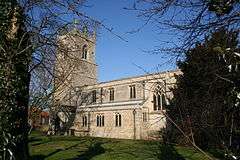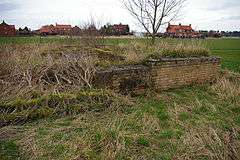Laughton, West Lindsey
Laughton is a village and a civil parish in the West Lindsey district of Lincolnshire, England. The population of the civil parish at the 2011 census was 410.[1] It is situated approximately 6 miles (10 km) north from the town of Gainsborough[2]
| Laughton | |
|---|---|
 Church of All Saints, Laughton | |
 Laughton Location within Lincolnshire | |
| Population | 410 (2011) |
| OS grid reference | SK849972 |
| • London | 150 mi (240 km) S |
| District | |
| Shire county | |
| Region | |
| Country | England |
| Sovereign state | United Kingdom |
| Post town | Gainsborough |
| Postcode district | DN21 |
| Police | Lincolnshire |
| Fire | Lincolnshire |
| Ambulance | East Midlands |
| UK Parliament | |
Nearby is Laughton Forest, mostly privately owned but leased to the Forestry Commission, which was created in the 20th century on a sandy heath.[3]
History
Laughton is listed in the 1086 Domesday Book, as "Lacestone" and "Lastone", with 29 households.[4]
Dr Roger Dalyson founded a village school in the reign of James I; a new school-house was built in 1821, funded by Isabella Ingram-Seymour-Conway, Marchioness of Hertford. [5] The Ingram family were the local landowners, giving their name to the Ingram Arms public house.
All Saints Church
The parish church is built of limestone, dedicated to All Saints, and is a Grade I listed building dating from the 12th century. It was restored and the chancel rebuilt in 1894 by Bodley and Garner.
Gothic brass
.jpg)
In the south aisle is a full length monumental brass, made in about 1405, showing a knight wearing the style of armour worn at the Battle of Agincourt (1415), with Gothic-style canopy, reset in 1549 with new imitation Gothic-style inscription, to serve as the ledger stone for William Dalison (died 1546) of Laughton, Sheriff of Lincolnshire in 1546 and Escheator of Lincolnshire. It is of a style and design similar to at least three surviving brasses namely those of:
- Sir Peter Courtenay (d.1405), KG, in Exeter Cathedral.
- Sir Maurice Russell (d.1416), Saint Peter's Church, Dyrham, Gloucestershire.
- Thomas Berkeley, 5th Baron Berkeley (d.1417), Church of St Mary the Virgin, Wotton-under-Edge, Gloucestershire.
Wildsworth Church

The village of Wildsworth is 2.5 miles (4.0 km) to the west on the bank of the River Trent. It had a yellow-brick church, dedicated to St John the Divine, built in 1838 by Charles Biggs. It was declared redundant by the Diocese of Lincoln in 1982 and demolished two years later.[2][7] It is still listed on the National Heritage List for England as a Grade II listed building, where it is described as disused.[8]
References
- "Civil Parish population 2011". Neighbourhood Statistics. Office for National Statistics. Retrieved 22 May 2016.
- "Laughton by Gainsborough". Vision of Britain. University of Portsmouth. Retrieved 31 July 2011.
- "The History of Laughton Forest 1926 - 2013", Laughtonforest.blogspot.co.uk/
- "Laughton". Domesday Map. Anna Powell-Smith/University of Hull. Retrieved 31 July 2011.
- "Laughton - Laverstoke Pages 33-37 A Topographical Dictionary of England. Originally published by S Lewis, London, 1848". British History Online.
- "to a member of the D'Alison family"Historic England. "All Saints, Laughton (1317208)". National Heritage List for England. Retrieved 31 July 2011.
- "Laughton". Genuki.org.uk. Retrieved 31 July 2011.
- Historic England. "St John the Divine, Wildsworth (1165941)". National Heritage List for England. Retrieved 31 July 2011.
External links
